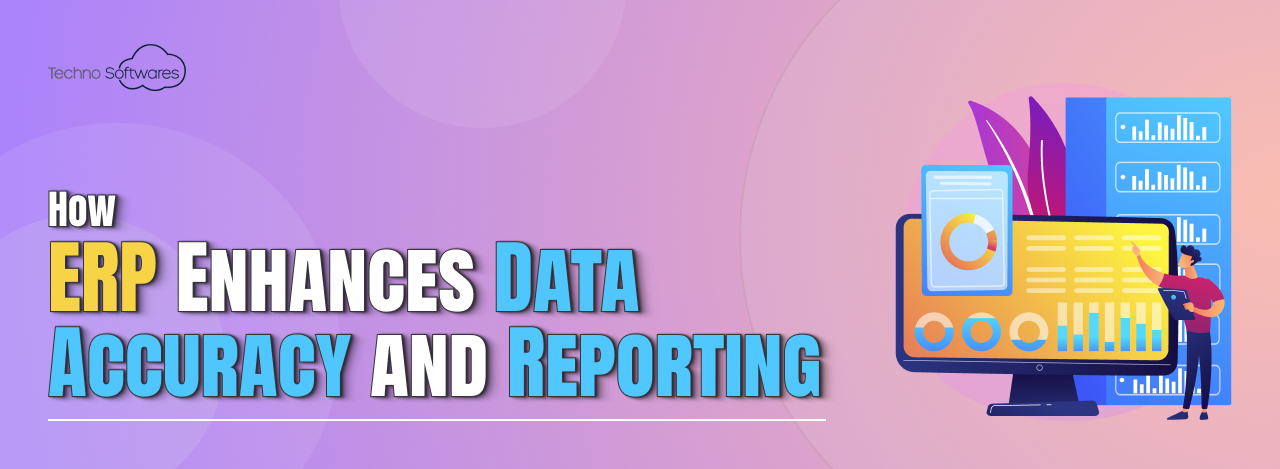How ERP Improves Data Accuracy and Reporting
In the ever-evolving landscape of business management, the importance of Enterprise Resource Planning (ERP) systems cannot be overstated. These comprehensive software solutions are designed to integrate various business processes, providing a unified platform for managing resources, finances, and operations. As we delve into the world of ERP, one critical aspect that stands out is data accuracy.
Accurate data is the backbone of effective decision-making, and without it, organizations risk making misguided choices that can lead to inefficiencies and lost opportunities. We recognize that data accuracy in ERP systems is not merely a technical requirement; it is a strategic necessity. When data is precise and reliable, it enhances operational efficiency, improves customer satisfaction, and ultimately drives profitability.
However, achieving high levels of data accuracy is often fraught with challenges. Inconsistent data entry, siloed information across departments, and outdated systems can all contribute to inaccuracies that hinder an organization’s performance. Therefore, as we explore the integration of real-time analytics with ERP systems, we must first understand how this synergy can significantly enhance data accuracy and reporting capabilities.
Key Takeaways
- Real-time analytics and reporting are essential for maintaining data accuracy in ERP systems.
- Integrating real-time analytics with ERP provides businesses with timely and actionable insights.
- Challenges in implementing real-time analytics can be overcome with proper data management and technology solutions.
- Successful case studies demonstrate the benefits of integrating real-time analytics with ERP for improved decision-making.
- Best practices for leveraging real-time analytics in ERP include data governance, user training, and continuous monitoring.
Real-Time Analytics and Reporting
Real-time analytics refers to the immediate processing and analysis of data as it becomes available. This capability allows organizations to gain insights into their operations almost instantaneously, enabling them to respond swiftly to changing conditions. In the context of ERP systems, real-time analytics transforms static data into dynamic insights that can inform decision-making processes.
By leveraging real-time data, we can monitor key performance indicators (KPIs), track inventory levels, and assess financial health with unprecedented immediacy. The significance of real-time reporting cannot be understated. Traditional reporting methods often involve delays that can render data obsolete by the time it is analyzed.
In contrast, real-time reporting provides us with a continuous stream of information that reflects the current state of our business. This immediacy allows us to identify trends, spot anomalies, and make informed decisions based on the most current data available. As we embrace this technology, we find ourselves better equipped to navigate the complexities of modern business environments.
Benefits of Integrating Real-Time Analytics with ERP

Integrating real-time analytics with ERP systems offers a multitude of benefits that can significantly enhance organizational performance. One of the most notable advantages is improved decision-making. With access to real-time data, we can make informed choices based on current trends rather than relying on historical data that may no longer be relevant.
This agility allows us to respond to market changes swiftly and effectively, positioning our organization for success in a competitive landscape. Moreover, the integration fosters greater collaboration across departments. When all teams have access to the same real-time data, it breaks down silos and encourages a culture of transparency.
For instance, sales teams can see inventory levels in real time, allowing them to manage customer expectations more effectively. Similarly, finance teams can monitor cash flow in real time, enabling them to make proactive financial decisions. This interconnectedness not only enhances operational efficiency but also cultivates a more cohesive organizational culture.
Challenges and Solutions in Implementing Real-Time Analytics
While the benefits of integrating real-time analytics with ERP systems are compelling, we must also acknowledge the challenges that come with implementation. One significant hurdle is the complexity of integrating disparate systems. Many organizations operate with legacy systems that may not easily connect with modern analytics tools.
This lack of compatibility can lead to data silos and hinder our ability to achieve a unified view of operations. To overcome these challenges, we must prioritize strategic planning and invest in robust integration solutions. Adopting middleware or cloud-based platforms can facilitate seamless connections between existing ERP systems and new analytics tools.
Additionally, we should focus on training our teams to ensure they are equipped to leverage these technologies effectively. By fostering a culture of continuous learning and adaptation, we can navigate the complexities of implementation and fully realize the potential of real-time analytics.
Case Studies of Successful Integration of Real-Time Analytics with ERP
Examining case studies of organizations that have successfully integrated real-time analytics with their ERP systems provides valuable insights into best practices and potential outcomes. For instance, a leading manufacturing company implemented a real-time analytics solution alongside its ERP system to monitor production processes. By analyzing data in real time, they identified bottlenecks in their supply chain and made adjustments that resulted in a 20% increase in production efficiency within just six months.
Another compelling example comes from a retail organization that integrated real-time analytics into its ERP system to enhance inventory management. By utilizing predictive analytics, they were able to forecast demand more accurately and optimize stock levels accordingly. This proactive approach not only reduced excess inventory costs but also improved customer satisfaction by ensuring popular products were always available.
These case studies illustrate how organizations can harness the power of real-time analytics to drive significant improvements in efficiency and customer service.
Best Practices for Leveraging Real-Time Analytics in ERP

To maximize the benefits of real-time analytics within our ERP systems, we must adhere to several best practices. First and foremost, establishing clear objectives is essential. We should define what we aim to achieve through the integration of real-time analytics—whether it’s improving operational efficiency, enhancing customer service, or driving revenue growth.
By setting specific goals, we can tailor our analytics efforts to align with our overall business strategy. Additionally, investing in user-friendly analytics tools is crucial for ensuring widespread adoption across the organization. If our teams find the tools cumbersome or difficult to navigate, they may be less inclined to utilize them effectively.
Therefore, selecting intuitive platforms that provide actionable insights in an easily digestible format will encourage engagement and drive better decision-making.
Future Trends in Real-Time Analytics and ERP Integration
As we look ahead, several trends are poised to shape the future of real-time analytics and ERP integration. One notable trend is the increasing use of artificial intelligence (AI) and machine learning (ML) technologies. These advanced tools can analyze vast amounts of data at unprecedented speeds, uncovering patterns and insights that may not be immediately apparent to human analysts.
By incorporating AI-driven analytics into our ERP systems, we can enhance predictive capabilities and make even more informed decisions. Another trend is the growing emphasis on data visualization techniques. As organizations generate more data than ever before, presenting this information in a visually appealing and easily understandable format becomes paramount.
Interactive dashboards and visual reporting tools will enable us to grasp complex data sets quickly and make informed decisions based on visual insights rather than raw numbers alone.
The Impact of Real-Time Analytics on Data Accuracy and Reporting
In conclusion, the integration of real-time analytics with ERP systems represents a transformative opportunity for organizations seeking to enhance data accuracy and reporting capabilities. By leveraging real-time insights, we can make informed decisions that drive operational efficiency and improve overall performance. While challenges exist in implementing these technologies, strategic planning and investment in user-friendly tools can pave the way for successful integration.
As we continue to embrace advancements in technology, we must remain vigilant in our pursuit of accurate data and effective reporting practices. The future holds immense potential for organizations willing to adapt and innovate in this space. Ultimately, by harnessing the power of real-time analytics within our ERP systems, we position ourselves not only for immediate success but also for sustained growth in an increasingly competitive business environment.
If you are interested in learning more about the benefits of choosing a custom software development company for your business, check out this article on choosing custom software development company services. Custom software can help streamline processes and improve efficiency, ultimately leading to better data accuracy and reporting. By selecting the right technology stack for your project, as discussed in this article on choosing the right technology stack, you can ensure that your ERP system integrates seamlessly with real-time analytics. Additionally, understanding what’s really happening with iPhone development services, as outlined in this article on iPhone development services, can help you stay ahead of the curve in terms of mobile technology integration.
FAQs
What is ERP?
ERP stands for Enterprise Resource Planning, which is a software system that helps organizations manage and integrate their core business processes such as finance, HR, supply chain, and manufacturing.
How does ERP improve data accuracy?
ERP systems improve data accuracy by centralizing all business data into a single database, which reduces the chances of errors and inconsistencies that can occur when data is stored in multiple systems.
How does ERP improve reporting?
ERP systems improve reporting by providing real-time access to accurate and up-to-date data, which allows for better decision-making and more accurate forecasting.
How can Techno Softwares integrate real-time analytics with ERP?
Techno Softwares can integrate real-time analytics with ERP by using advanced reporting and analytics tools that connect directly to the ERP system, allowing for real-time data analysis and visualization.
What are the benefits of integrating real-time analytics with ERP?
Integrating real-time analytics with ERP allows for better insights into business performance, improved decision-making, and the ability to quickly identify and respond to changing market conditions.





